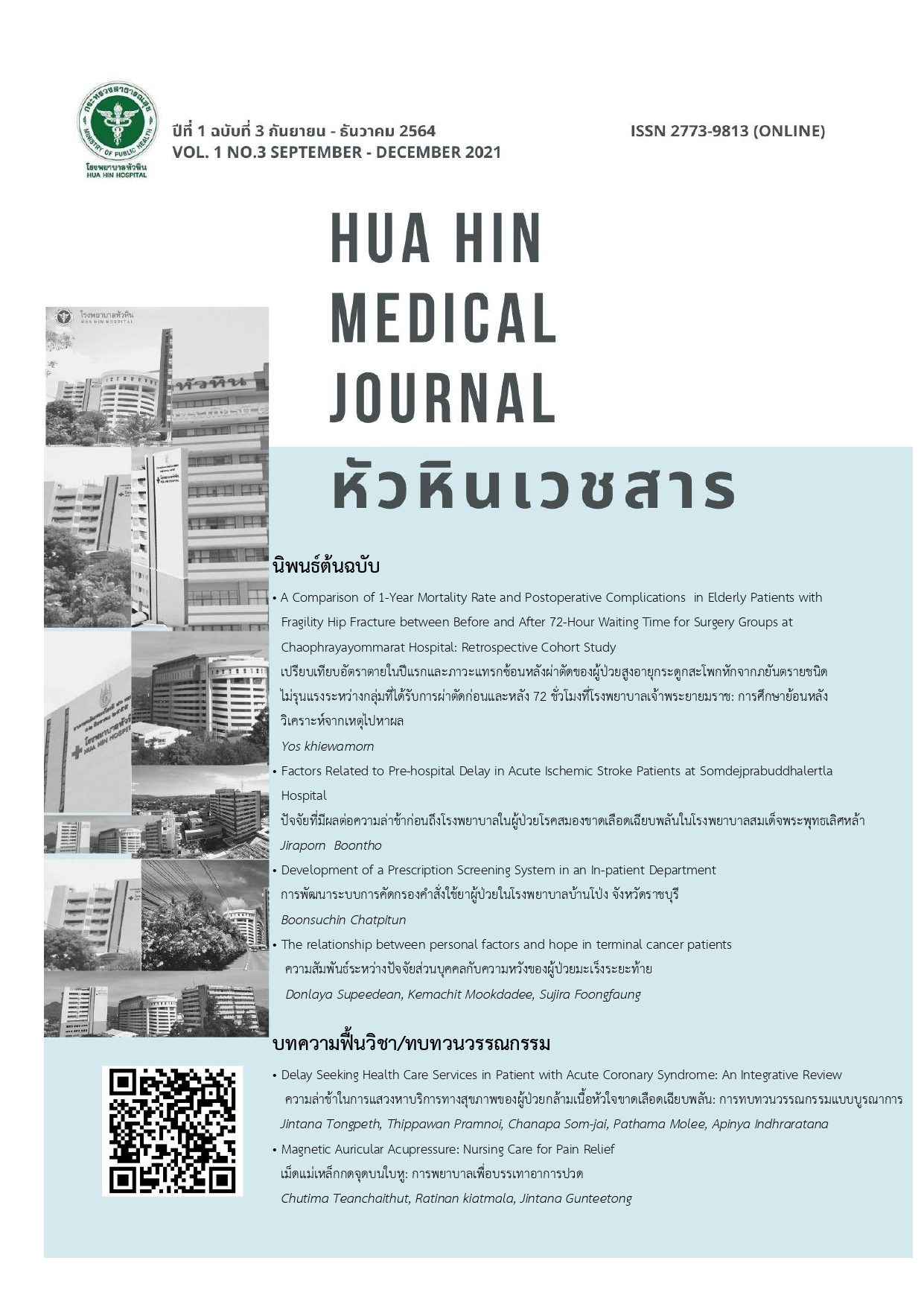Magnetic Auricular Acupressure: Nursing Care for Pain Relief
Keywords:
Keywords: Magnetic Auricular Acupressure, Nursing Care, Pain ReliefAbstract
Pain has long been a major health issue, affecting not only patients’ lives but also their families, health care providers, and health care systems. The use of auricular acupoints originated in China more than 2,000 years ago. The use of magnets as a component of complementary and alternative medicine is increasingly common. In general, magnetic auricular acupuncture is the stimulation of specific acupuncture points through the skin with magnetics, which aims to correct imbalances in traditional Chinese medicine. Nowadays, there are several non-pharmacological strategies for pain management. The magnetic auricular Acupressure is simple, non-invasive and has no drug side effects. As a non-invasive, semi-self-managed, non-pharmacological technique for pain relief, magnetic auricular acupressure has minimal side effects and, therefore, may be particularly acceptable to Pain Relief. This paper introduces auricular point acupressure, a magnetic auricular acupuncture technique that (1) features the use of magnetic instead of needles and (2) treats only the acupoints located on the surface of the ear. The technique not only offers a less invasive alternative to acupuncture, but also can be self-managed the patient is instructed to press the points on which the magnetic have been placed at regular intervals and as needed to decrease pain. Nurses can use magnetic auricular acupressure on nursing practice for pain management.
References
1. สำนักงานคณะกรรมการพัฒนาการเศรษฐกิจและสังคมแห่งชาติ สำนักนายกรัฐมนตรี. แผนพัฒนาเศรษฐกิจและ
สังคมแห่งชาติฉบับที่ 12 (พ.ศ. 2560 – 2564). [อินเตอร์เน็ต].2563 [เข้าถึงเมื่อ 27 กรกฎาคม 2563] เข้าถึงได้จากhttps://www.nesdc.go.th/ewt_dl_link.php?nid=6422
2. ศรีนวล โอสถเสถียรและคณะ. การพยาบาลครอบครัวและการผดุงครรภ์หน่วยที่ 11-15. เอกสาร
การสอน มหาวิทยาลัยสุโขทัยธรรมาธิราช สาขาพยาบาลศาสตร์. สำนักพิมพ์มหาวิทยาลัยสุโขทัยธรรมาธิราช, 187-198. 2546.
3. รตินันท์ เกียรติมาลา. ดุลยภาพบำบัด : กระบวนทัศน์ใหม่ทางการพยาบาล. วารสารการศึกษาพยาบาล, 15(3), 95-104. 2547.
4. Terry Oleson. Auriculotherapy Manual : Chinese and Western systems of Ear Acupuncture, Third edition. Health care alternatives Los Angeles California. 2003.
5. วิเชียรชัย ผดุงเกียรติวงษ์. การกดจุดบนใบหู. เอกสารประกอบการสอนการประชุมวิชาการเรื่องการกดจุดบนใบหูเพื่อบรรเทาอาการปวด,โรงพยาบาลพระจอมเกล้าจังหวัดเพชรบุรี. 2553.
6. Zita West. Acupuncture in pregnancy and child birth. foreword by Giovanni Maciocia CAc (Nanjing) Acupuncturist and Medical, UK; Visting Professor of the Nanjing University of Traditional Chinese Medicine, People’s Republic of China. Churchill Livingstone, 2009.
7. รตินันท์ เกียรติมาลาและคณะ. ผลของการใช้เม็ดแม่เหล็กกดจุดบนใบหูต่อความเจ็บปวดและความก้าวหน้าของการคลอดในโรงพยาบาลพระจอมเกล้าจังหวัดเพชรบุรี. รายงานวิจัย, วิทยาลัยพยาบาลพระจอมเกล้าจังหวัดเพชรบุรี. สถาบันพระบรมราชชนก สำนักงานปลัดกระทรวงสาธารณสุขกระทรวงสาธารณสุข. 2550.
8. ชนกพร ศิลธรรมกิจและคณะ. ผลของโปรมแกรมการสนับสนุนในระยะคลอดต่อพฤติกรรมการเผชิญความเจ็บปวดและประสบการณ์การคลอดในผู้คลอดครรภ์แรกที่ได้รับยาออกซิโทซิน. วารสารการพยาบาลทหารบก, 20(1), มกราคม – เมษายน. 2562.
9. Hantoushzadeh S, Alhusseini N, Lebaschi AH. The effects of acupuncture during labour on nulliparous women: a randomised controlled trial. Aust N Z J Obstet Gynaecol;47:26–30. 2007.
10. Borup L, Wurlitzer W, Hedegaard M, Kesmodel US, Hvidman L. Acupuncture as pain relief during delivery: a randomised controlled trial. Birth;36:5–12. 2009.
11. Martensson L, Stener-Victorin E, Wallin G. Acupuncture versus subcutaneous injections of sterile water as treatment for labour pain. Acta Obstet Gynecol Scand;87:171–7. 2008.
12. ภิรมย์ นานานุกูลและคณะ. ผลการใช้เม็ดแม่เหล็กกดจุดบนใบหูลดความเจ็บปวดจากแผลผ่าตัดของ
ผู้ป่วยหลังผ่าตัดไส้ติ่งอักเสบ. รายงานวิจัย,หอผู้ป่วยศัลยกรรมชาย,โรงพยาบาลพระจอมเกล้าจังหวัด
เพชรบุรี. 2552.
13. อรทัย จำนงค์ศิลป์และคณะ. ผลของโปรแกรมการจัดการกับอาการร่วมกับการกดจุดที่หูต่อความปวดในผู้ป่วยมะเร็งตับ ที่ได้รับการรักษาด้วยเคมีบำบัดทางหลอดเลือดแดง.วารสารพยาบาลสงขลานครินทร์, 36(3), กันยายน – ธันวาคม. 2559.
14. Lin, W. C., Yeh, C. H., Chien, L. C., Morone, N. E., Glick, R. M., & Albers, K. M. The anti-inflammatory actions of auricular point acupressure for chronic low back pain. Evidence-Based Complementary and AlternativeMedicine,1-9. 2015.
15. Yeh, M. L., Chung, Y. C., Chen, K. M., & Chen, H. H. Pain reduction of acupoint
electrical stimulation for patients with spinal surgery: A placebo-controlled
study. International Journal of Nursing Studies, 48(6), 703-709. 2011.
16. Suen, L. K., Wong, T. K., Chung, J. W., & Yip, V. Y. Auriculotherapy on low
back pain in the elderly. Complementary Therapies in Clinical Practice, 13(1),
63-69. 2007.
17. Yeh, M. L., Hung, Y. L., Chen, H. H., & Wang, Y. J. Auricular acupressure for pain relief in adolescents with dysmenorrhea: A placebocontrolled study. Journal of Alternative and Co-prementary Medicine, 19(4), 2013.
18. Wang, M. C., Hsu, M. C., Chien, L. W., Kao, C. H., & Liu, C. F. Effects of auricular acupressure on menstrual symptoms and nitric oxide for women with primary dysmenorrhea. Journal of Alternative and Complementary Medicine, 15(3), 2009.
19. Cha, N. H., & Sok, S. R. Effects of auricular acupressure therapy on primary dysmenorrhea for female high school students in South Korea. Journal of Nursing Scholarship, 48(5), 508-516. 2016.
Downloads
Published
How to Cite
Issue
Section
License
บทความที่ได้รับการตีพิมพ์ในวารสารหัวหินเวชสาร เป็นลิขสิทธิ์ของโรงพยาบาลหัวหิน
บทความที่ลงพิมพ์ใน วารสารหัวหินเวชสาร ถือว่าเป็นความเห็นส่วนตัวของผู้เขียนคณะบรรณาธิการไม่จำเป็นต้องเห็นด้วย ผู้เขียนต้องรับผิดชอบต่อบทความของตนเอง







